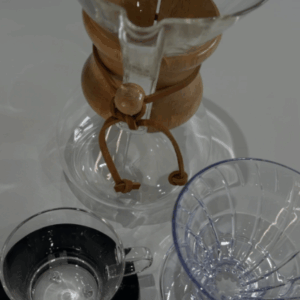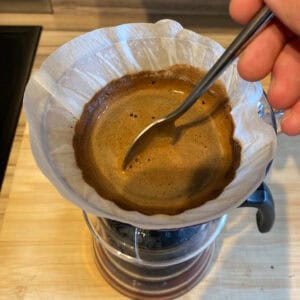What to Do if Your Coffee Filters are The Wrong Size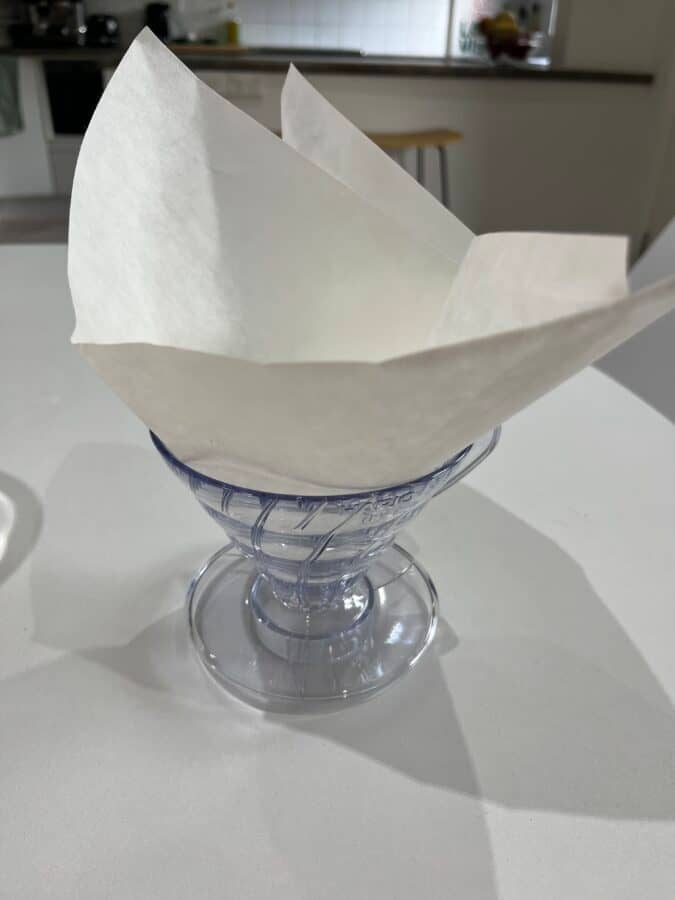
Filter coffee is arguably one of the purest forms of coffee brewing, using just gravity and the user’s technique to produce a delicious, clean tasting cup. Naturally, filter papers are a key ingredient in the filter coffee story, so if you’ve accidentally ordered the wrong size for your chemex, V60 or Kalita you may think you’re in trouble. However, if you’ve got your coffee filter orders wrong and they don’t fit your brewer, there’s no need to worry. You can easily adjust your brewing technique, fold your filter papers to fit your brewer or even use a substitute to save your filter coffee experience and not let freshly ground coffee go to waste.
So, if you’re looking for a way out of a filter coffee mess, you’ve come to the right place. In this article, I’ll give you an overview of filter coffee in general, what to do if your filter papers are too big, too small or the wrong size, and give you a number of tips to help improve your filter coffee experience overall.
What are Coffee Filter Papers?
Coffee filter papers are simply the filtration device used to separate ground coffee from the liquid that ends up in your cup. They are often made from paper rather than metallic mesh to strain out as much fine sediment and silt as possible, giving you a clean, smooth and light cup of coffee.
Filter papers are loved by coffee enthusiasts as they remove virtually all of the sediment from the bed of ground coffee, due to the very fine, densely packed holes within them. This allows plenty of delicious, smooth coffee to flow through, without allowing any unwanted silt into your cup.
This smooth, clean tasting cup of coffee is different from the more raw, intense and vicious end product that you might get from a metallic filter, such as those used in an espresso machine or french press. The holes are much wider in a metallic filter, allowing much more fine sediment to enter your cup.
Coffee filter papers are used in drip brew coffee devices, which use gravity and pouring technique to extract coffee oils into your cup. This is in contrast to immersion brewing (French Press, Cold Brew and AeroPress) or pressure based brewing (Espresso and Moka Pot) which use more drawn out and intense coffee extraction methods respectively.
Whether you use a bleached (white) or unbleached (brown) coffee filter paper is up to you. There is an argument that unbleached coffee filter papers offer a more ‘papery’ taste, but if either of these coffee filter papers are wetted before use, pretty much any residual taste will fade away.
Here is a comprehensive filter paper size guide for Chemex, V60, Kalita, Melita, Drip Brew Machines:
| Brewer | Filter Type | Filter Size Name | Common Dimensions | Shape | Cups Brewed | Notes |
| Chemex | Chemex filters | FP-1 (3-cup) | ~4.5 in (diameter when folded) | Cone / Circle-fold | 1–3 cups | For small Chemex brewer (CM-1). Only fits 3-cup Chemex models |
| FS-100 (6–10 cup) | ~6.25 in square, folded into cone | Cone / Square-fold | 6–10 cups | For Classic Series 6, 8, and 10 cup brewers | ||
| Hario V60 | Hario V60 filters | Size 01 | ~4.5 in diameter (flat) | Pointed Cone | 1–2 cups | Perfect for solo brews |
| Size 02 | ~5.2 in diameter (flat) | Pointed Cone | 1–4 cups | The most popular and versatile V60 size | ||
| Size 03 | ~6.3 in diameter (flat) | Pointed Cone | 1–6 cups | Ideal for large batches or sharing | ||
| Kalita Wave | Kalita Wave filters | Wave 155 | ~4.5 in diameter | Flat-bottom, wavy | 1–2 cups | Use only with Kalita Wave 155 drippers |
| Wave 185 | ~6 in diameter | Flat-bottom, wavy | 2–4 cups | Use with Wave 185 drippers, brews larger batches | ||
| Melitta (Cone) | Melitta cone filters | #1 | ~4.5 in tall | Flat-bottomed cone | 1 cup | Compact size, often used in single-serve brewers |
| #2 | ~5.25 in tall | Flat-bottomed cone | 2–4 cups | Common for small pour-over cones and drip machines | ||
| #4 | ~6 in tall | Flat-bottomed cone | 8–12 cups | Fits most 8–12 cup drip coffee makers with cone filters | ||
| #6 | ~7 in tall | Flat-bottomed cone | 10–12 cups | Less common, used in very large brewers | ||
| Drip Brew Machines | Basket filters | Junior / Small | ~7–8 in diameter | Flat-bottom basket | 4–6 cups | Found in smaller automatic drip machines |
| Standard (8–12 cup) | ~8.5–9.75 in diameter | Flat-bottom basket | 8–12 cups | Most popular for classic automatic brewers like Mr. Coffee, Braun | ||
| Cone-style (if supported) | #2, #4, #6 | Same as Melitta above | Cone | Varies with model | Some drip machines use cone filters—check your manual |
What is Filter Coffee?
Filter coffee is made by pouring hot water over ground coffee and passing the liquid through a fine paper filter, separating the coffee grounds, sediment and fines from the final cup. Coffee oils and dissolved solids are extracted using percolation, as water passes through the bed of coffee and drips down into the drinking vessel below. Filter coffee is therefore also known as ‘drip brew’ coffee, and tends to have a more subtle, clear and nuanced flavour profile than espresso for example.
Filter coffee tends to take a longer time to brew than espresso, due to lower heat and pressure used for extraction. The dose of ground coffee used also tends to be higher than espresso, resulting in a higher caffeine content and a more balanced, but less intense taste.
All coffee brewing methods use some form of filtration to separate the ground coffee from ending up in your cup. However some go about this in a slightly different way than others, allowing a small amount of coffee solids into your cup in the form of silt or residue.
Filter coffee brewing devices include the V60, Chemex, Kalita, Mellita, Clever Dripper, Aeropress (debatable), automatic drip brew machines and Chemex.
What to Do if Your Coffee Filters are The Wrong Size
If you find yourself with inappropriately sized filter papers, there’s a few things you can do to salvage the situation. First off, think craftily and use your imagination. It’s important not to panic or stress, as most likely the situation is salvageable.
Filter Papers too Big
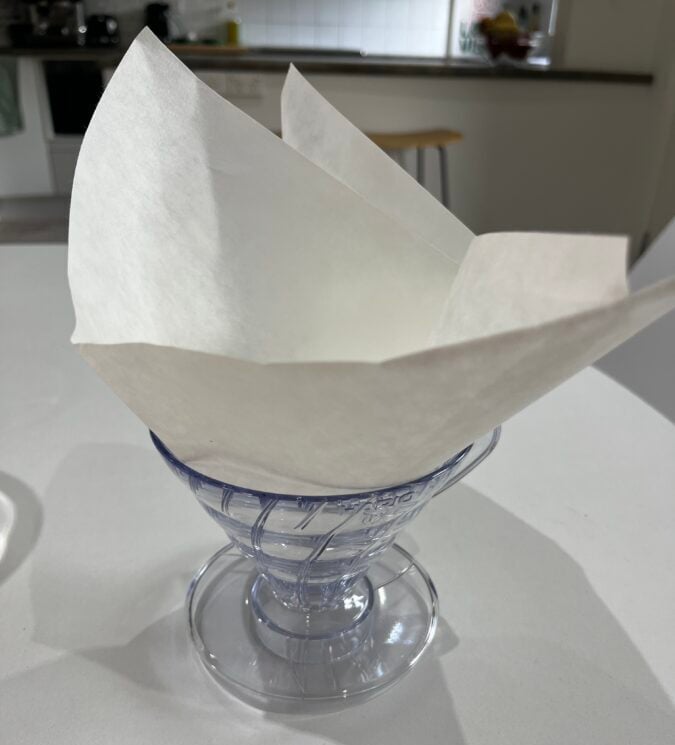
If your filter papers are too big, you can simply trim down the edges of them to more snuggly fit your chosen vessel. You may find that your filter paper of choice is thicker than you’d normally use, so you may need to use a lower dose of coffee, or pour water and agitate the grounds more vigorously to compensate. These tips should help increase the flow rate and give you a smooth, balanced cup of coffee.
Filter Papers Too Small
If your coffee filter papers are too small for your chosen brewing device, this can be sorted out too. Depending on the disparity in size, you could simply use the smaller filter papers (as shown below), but be careful not to overfill the paper with too much coffee or water.

The key when using coffee filter papers that are too small, is to focus on a careful and gentle pour over technique, so you don’t get grounds overflowing into your cup. Use small concentric circular pours to top up your coffee slurry.
Remember, adding too much weight (in the form of coffee and/or water) will run the risk of the whole thing collapsing in on itself and making a big mess.
Filters Wrong Shape
If you only have coffee filter papers that are the wrong shape for your brewing device (as shown below), you may still be able to make a delicious brew, but it will be more of a challenge.
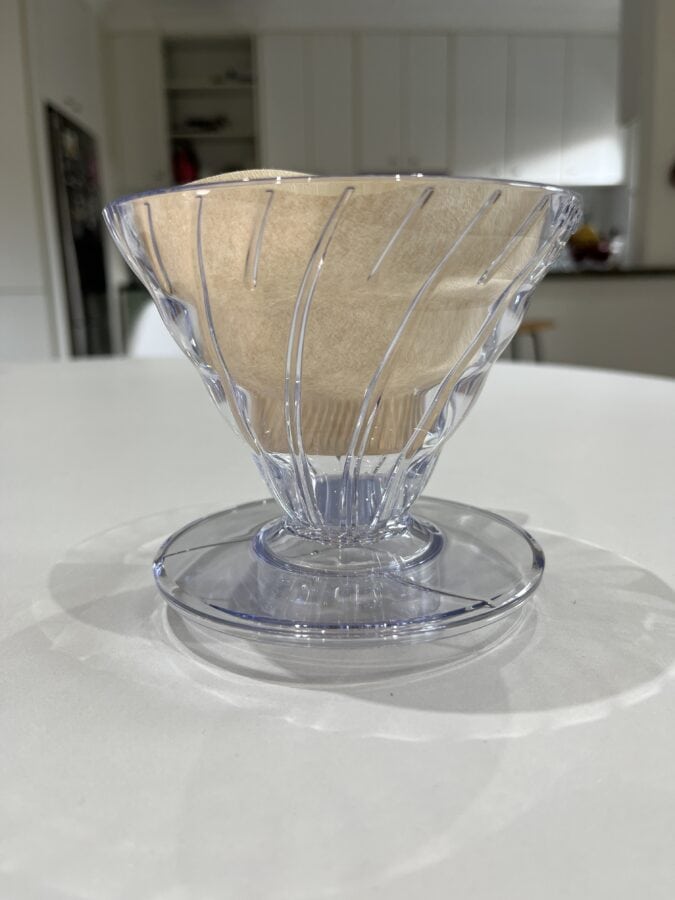
You may be able to fold the bottom a conical shaped filter up if you’re using a flat bottomed brewer like a Mellita or Kalita Wave.
Conversely, if you’re using a conical dripper like a V60 or Chemex, but only have a flat bottomed filter paper available, you could simply use it as is, or fold in the sides to give you a more pointed bottom.
Other Filter Coffee Tips
Here’s a few additional tips to help with perfecting your filter coffee technique even further.
Use Freshly Ground Coffee
If you can get your hands on it, I’d always advise to use freshly ground coffee wherever possible over the pre-ground stuff. Coffee beans that have just been ground in a burr grinder will retain significantly more of their freshness, underlying flavour notes and above all, they’ll taste a lot more vibrant than coffee that’s been ground weeks or months ago.
The only exception to this is if you only have access to a blade grinder (that’s typically used for grinding spices rather than coffee). In this situation, I would recommend using pre-ground coffee that’s stored in a bag with a reverse valve, as this will preserve the freshness as much as possible.
Use a Gooseneck Kettle
Whilst certainly not essential, using a gooseneck kettle will help control the flow of water over your coffee bed, which will give you a better chance of even extraction.
If you use a regular kettle to brew filter coffee, be sure to pour with a thin stream of water in a circular motion, starting from the centre and working your way out.
Pour in a Slow Circular Motion
Pouring in a circular motion rather than just flooding your coffee bed with a load of hot water will help you brew a balanced cup of coffee.
If you have a small concentration of grounds that are over extracted, whilst having a load that are under extracted, you’ll likely end up with a cup of coffee that doesn’t live up to its full potential.
You run the risk of it being both bitter, sour and weak all at the same time, by not extracting coffee at an even rate throughout the bed of grounds.
Try a Lighter Roasted Coffee Bean
Filter coffee tends to lend itself to brewing medium to lighter roasted beans, due to the slower and less intense extraction methodology.
Brewing a lighter roast in a French Press, with an Espresso Machine or Aeropress may result in losing those delicate floral, fruity or citrus notes thanks to the intense extraction process.
Brewing filter coffee with a lighter roasted bean will make the most of the brewing equipment in front of you.
Use the Right Brew Ratio
As a general rule of thumb, most filter coffee brewing methods recommend a 1:16 coffee to water ratio. This is widely acknowledged as the gold standard of coffee brewing, balancing sweetness, depth of flavour, extraction and nuance.
Of course, the amount of coffee and water you end up using will depend upon your taste preferences, how many people you’re brewing for and what coffee beans you’re using.
But moving wildly outside of these parameters will most likely result in a dramatic over or under extraction of your coffee, which in turn will probably leave you with a sour (or bitter) taste in your mouth.
Bloom Your Bed of Coffee
Finally, blooming your coffee bed before continuing your pour will help release excess CO2 that’s built up during the roasting process.
Blooming involves pouring a small quantity of hot water over the bed of coffee at the start of the brewing process, allowing the grounds to swell up and release excess gas before proceeding with the rest of the water.
Summary
Overall, if you find yourself using the wrong size filter papers when making pour over coffee, there are a few ways to get around the problem. Depending whether your filters are too big, too small or the wrong shape altogether, you’ll be able to make adjustments like cutting, folding or being more careful with your brew technique.
Either way, there’s always a way around the issue and there’s no need to panic or give up on your brew. I hope you’re found this article useful and please feel free to explore the site for more coffee tips, hacks and reviews.
Coffee Filter Paper Frequently Asked Questions
No, there are dedicated sizes of coffee filter papers depending on your brewing device, as well as the specific size of device you’re bought. Make sure to carefully inspect your brewing equipment for size numbers and codes before buying filter papers.
Whilst it is possible to use a paper towel as a replacement for authentic coffee filter papers, it really should only be done as a last resort. I’ve written an article about substitutes for filter papers so check it out if you find yourself in this position.
There’s no right or wrong when it comes to coffee brewing methods. Filter coffee tends to be smoother, more delicate and exemplifies the nuances of lighter roasted coffee beans more readily. On the other hand, espresso is used as the basis for a wide range of drinks, if quicker to make and is (arguably) less reliant on manual brewing technique than filter coffee.


